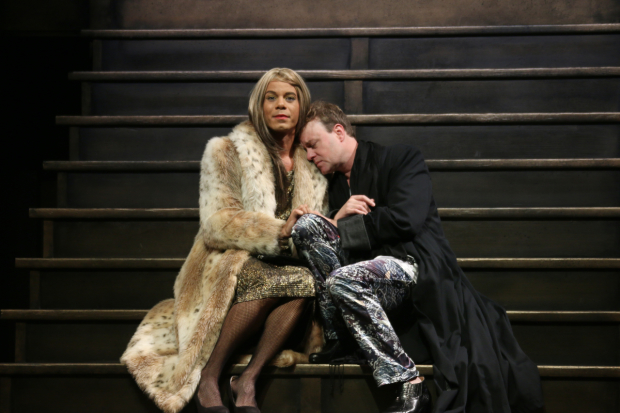Angels in America, Part II: Perestroika

(© Danisha Crosby)
In early September, a superior production of Part I of Tony Kushner's Angels in America opened at Round House Theatre. Now, an equally fine Part II has opened and will run in repertory with Part I until October 30.
Part I might well have been subtitled Apocalypse Now, with its depiction of disasters and personal tragedies on every hand. It takes place in 1985 when gay men are dying of AIDS, individual relationships are on the rocks, and nearly all the play's characters question if the human race is doomed. Part II picks up where Part I left off. It is December, 1985 in New York City and the characters from the first part of the play reappear. Prior Walter, a young man with AIDS, is trying to recover from the fact that his lover, Louis Ironson, deserted him when he found out Prior was sick. Louis is infatuated with the handsome Joe Pitt, a deeply closeted Mormon attorney who has recently left his wife, Harper, and admitted to his mother that he is gay. Soon Louis convinces Joe to live with him.
Harper, meanwhile, has become addicted to Valium and is descending into madness. Joe's mother has flown in from Salt Lake City to try to convince her son to avoid the sin of homosexuality. Roy Cohn, the foulmouthed, deal-making lawyer, is also dying of AIDS, though publicly he says he has liver cancer. He is nursed by Belize, a friend of Prior's, and is haunted by the ghost of Ethel Rosenberg, who died because of Cohn's machinations.
The outstanding cast all double in many roles. Tom Story continues to play Prior with a brilliant schizophrenic twist, as a combination of a young man with a comic take on life yet with a darkly serious side of someone who is driven to distraction by the fact that he sees his death approaching. In this half of the play, the Angel who came to Prior at the end of Part I comes back at the beginning of Part II and insists that Prior is a prophet. Dawn Ursula is excellent in this role, as the powerful, definitive angel, who spends a great deal more time suspended in air than in her appearance in Part I. Louis is performed well by Jonathan Bock. He insists on seeing Prior again, though the meeting does not go well. It is clear that Louis is not sorry for what he has done to Prior, nor does he understand how deeply he wounded Prior.
The women's roles are expanded considerably in Part II. Kimberly Gilbert is droll, sad, and naive as Harper. In this play, she has settled into a routine, going to the Mormon Visitors Center every day to watch the diorama of the Mormon pioneers and wish she could be in it. Sarah Marshall is brilliant in several roles. In this play she is particularly fine as Ethel Rosenberg, hovering around the dying Roy Cohn, taunting him for the things he did in life, and as Hannah, Joe's mother, who takes care of Harper.
While the more flamboyant scenes with Roy Cohn (Mitchell Hébert) are in Part I, here he keeps trying to fight for life from his hospital bed. There is one character who must withstand the final fury of Cohn's racial slurs and vitriol: Belize, who is played with eminent style and grace by Jon Hudson Odom. In Perestroika we are treated to a special act of kindness that Belize performs to save Prior's life.
Ryan Rilette deftly directs this play so that there are very few gaps and silent moments. Lighting designer York Kennedy often carves out a small space on the stage with a spotlight to direct attention to it. Perestroika again uses James Kronzer's set, with occasional set pieces rolling onstage on silent casters. A broad staircase in the center of the stage leads to a balcony. Frosted glass stretches across the upper third of the stage, allowing wood-framed windows to reveal special scenes: a hammer and sickle, the Mormon diorama, and snow.
Round House Theatre and the Olney Theatre Center do a great service to the public who might not have seen Angels in America the first time around. It's an epic work that deserves a revival 25 years after its premiere. A great deal has happened in America over those years, and indeed, in its insistence on the tempestuousness of its era and the instability of its characters, Perestroika suggests that – when it ends in 1990 – nothing is permanent except eternal change.











